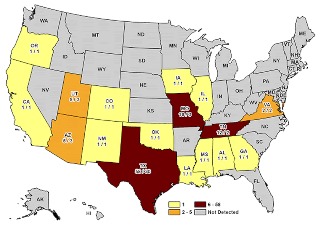By Coco Lederhouse
A persistent and potentially growing concern, according to experts, is the running of unsanctioned, informal horse races.
On Jan. 9, the AVMA House of Delegates approved a new AVMA policy condemning unregulated horse racing (PDF) during its regular winter session.
The policy states that the AVMA condemns unregulated racing of equids because of threats to animal health and welfare, such as infectious disease, administration of illegal substances, and abusive practices.
Cause for concern
“The bush tracking situation of today is very sophisticated,” said Dr. Angela Pelzel-McCluskey, an equine epidemiologist at the U.S. Department of Agriculture Animal and Plant Health Inspection Service’s Veterinary Services in Fort Collins, Colorado. “They communicate all online. Their fan base is expanding exponentially because of their use of social media to advertise and market their races.”
Dr. Pelzel-McCluskey oversees the federal response to outbreaks of reportable equine diseases nationwide. She said there are over 100 known bush tracks in the United States and hundreds more that haven’t been investigated. There are bush tracks in every state.
A key distinction between sanctioned and unsanctioned racing is that there are no rules for horse or rider safety in unsanctioned racing, Dr. Pelzel-McCluskey said. Race surfaces are not maintained, and no protocols are in place to protect the riders and horses from catastrophic breakdown. Injuries are common, and horses are subjected to excessive whipping and electronic shock devices.
And unlike sanctioned racing, there are not track veterinarians on-site at bush tracks to examine every horse, nor is there monitoring of medications or restricted drugs.
Outbreaks associated with bush tracks
The USDA has found that clusters of cases of equine infectious anemia and equine piroplasmosis in Quarter Horse racehorses are often associated with unsanctioned racing.
Unhygienic practices being used by horse owners and trainers in this high-risk population have contributed to disease spread, including the reuse of needles, syringes, and intravenous administration sets between horses; blood doping; and administration of drug products contaminated by nonsterile handling techniques.

Veterinarians should also consider that horses participating in unsanctioned racing may be at high risk for equine piroplasmosis, according to the 2013 JAVMA article “Babesia equi–induced anemia in a Quarter Horse and subsequent regulatory response.”
Equine piroplasmosis, which typically spreads via ticks, has also been linked to horses at unregulated racing events. In these cases, investigators have found the disease’s vector was unlicensed handlers using contaminated needles and other equipment to inject or dope the horses.
Veterinarian involvement
A 2012 JAVMA article, “Outbreak of equine piroplasmosis in Florida,” stressed the role of veterinarians in private practice and veterinary diagnostic laboratories in recognizing and reporting horses potentially exposed to EP.
“We want veterinarians to be very aware that we have horses in this population that are at high risk for these diseases,” Dr. Pelzel-McCluskey said. “Once identified, they really need to work with these clients to share the information that the horse may have been exposed and provide the proper advice to the client about testing the horse.”
While knowledge and awareness about bush tracks have increased, Dr. Pelzel-McCluskey argued that there is a need for law enforcement authorities to address the criminal activity. She also suggested that a law be authored with the help of the equine industry to make unsanctioned racing illegal.
“The solution is what needs to come next, and the industry has to decide what that is,” she said.
Click here to see more...